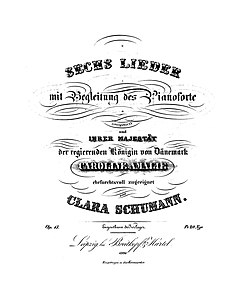6 Lieder mit Begleitung des Pianoforte, op. 13
Aparença
 | |
| Títol original | 6 Lieder mit Begleitung des Pianoforte (de) |
|---|---|
| Forma musical | cicle de cançons |
| Compositor | Clara Schumann |
| Lletra de | Heinrich Heine Emanuel Geibel Friedrich Rückert |
| Llengua | alemany |
| Creació | dècada del 1840 |
| Data de publicació | 1844 |
| Gènere | romanticisme musical |
| Format per | Ich stand in dunkeln Träumen Der Mond kommt still gegangen Ich hab’ in deinem Auge Liebeszauber Sie liebten sich beide Die stille Lotosblume |
6 Lieder mit Begleitung des Pianoforte, op.13 és un cicle de lied compost per Clara Wieck entre el nadal de 1840 i l'estiu de 1843.[1]
Les cançons
[modifica]L'op.13 és una col·lecció de sis cançons, no un cicle en sentit estricte.[1] Els poemes són d'Emanuel Geibel, Heinrich Heine i Friedrich Rückert.[2]
- Ich stand in dunkeln Träumen (Heine)
- Sie liebten sich beide (Heine)
- Liebeszauber (Geibel)
- Der Mond kommt still gegangen (Geibel)
- Ich hab’ in deinem Auge (Rückert)
- Die stille Lotosblume (Geibel): les irregularitats rítmiques, els cromatismes i el pathos de la melodia, juntament amb les imatges típicament romàntiques de la flor de lotus, el mar, la lluna i el cigne fan que sigui considerada una cançó paradigmàtica del romanticisme musical.[1]
Referències
[modifica]- ↑ 1,0 1,1 1,2 Reich, Nancy B.. Clara Schumann: The Artist and the Woman. Nova York: Cornell University Press, 2013, p. 238.
- ↑ «Oxford Lieder - Sechs Lieder (1844) op.13».
